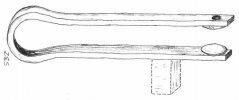Mike
thank you for that explanation. I do believe this is (well) over built as you said.
and true the welds are the key here,,
I took some things out of context to push my point.. mostly in a what if situation that you had covered in this being over built in the first place.
what I was attempting, was, if it could be over powered what would happen
to the lower parts
and yes other things sure would let loose first..

I think as you too if you do bring the one tube up under the plate that would be great. bringing in the side welds.
and as these are drops why not put two there

while thinking about it , the point of the inside tubes being at that length could be as an added benefit if there were
any lower tube deflection, this would cause a side tube deflection lessening the chances of a weld brake
was that what you were taking about other benefits?
well something like that .
like I said I can't type what I'd like to say.. so I'll stop.
I hope you all had a great time today I did, I think my youngest boy is showing me up on skies now.
one problem though with the press now..,,,

you got the feet on the wrong sides

come on guys..
that was a,,,, I'm kidding funny



